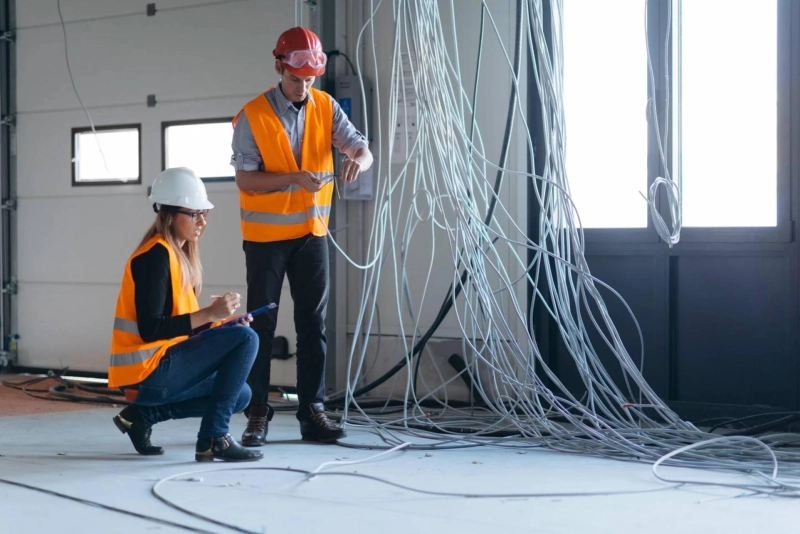Construction projects are quickly increasing over the world as a result of major business investment. As development progresses, additional attention should be paid to ensuring that effective product testing is carried out, particularly in the case of cable products.
Because much of the infrastructure is new, architects frequently require that the building materials used must match their own standards, whether they are local or well recognised international standards. Australian Cable Manufacturers frequently specify that all installed products must be certified or approved to these criteria in order to demonstrate their quality. Product certification supplied by an independent recognised testing facility is an easy approach to check quality.
Knowledge of proven quality standards and how to apply them is a specification technique that has sparked widespread desire for standardisation across the region. However, there is fear that those defining the products may not understand the true significance of why certified products must be utilised, and therefore their full benefit may not yet be realised.
Cable quality is sometimes overlooked in favour of other, more apparent construction materials or components utilised in building design and construction. As a result of being put last after a large portion of the project budget has already been spent, low-quality cable products may be deployed. If something goes wrong with a low-quality or unsafe product, it poses a larger risk to the individuals who live or work in the structures.
What is the point of having cable?
Equipment and machinery will not perform as designed if cables are faulty or damaged, resulting in an inability to fulfil critical activities and raising the possible risks that a failed electrical product poses to end users.
The majority of cables are developed and built with materials that are suitable for a certain application, such as Fire Cable, which must be fire resistant. If an unsuitable cable was specified for use with a fire alarm product, the unsuitable product would burn and degrade in the case of a fire. As a result of the damage to the cable, the fire alarm may fail to inform the building's residents to the fire danger, potentially increasing the risk of death. It is therefore recommended that you establish your requirements early in the specification phase so that the appropriate cable product and standards can be used to meet the application criteria.
Different types of cable testing
Fire testing shows what occurs when a cable catches fire and ensures that it can continue to work in the event of a fire. When wires catch fire, they can release a lot of heat, smoke, toxic or corrosive chemicals, and flame materials. The volume and spread of these pollutants can have a big impact on how quickly a fire spreads. As cables wind their way around a building, they can create a conduit for fire to spread swiftly.
While fire testing of cables is critical, overall performance should be validated through a comprehensive testing process. Testing is necessary to guarantee that flexible power cable are fit for purpose, will function under difficult situations, and will not fail electrically, mechanically, or otherwise, sparking and causing a fire. To guarantee that all cables fulfil quality and safety standards, as well as necessary legal requirements, they should be tested for a variety of features.
What other characteristics are essential?
The following explanations will help you understand why, in addition to fire testing, you should examine extra performance parameters in your cable goods.
Electrical testing uses voltage and specialised laboratory equipment to evaluate the performance of insulation, conductors, and cable armour. The most common tests in standards are high voltage and insulation resistance tests, which are designed to discover faults and ensure that insulation quality is consistent across all cables. Conductor resistance testing determines the quantity and quality of conductor material in a cable, guaranteeing that it can carry the current it was designed to carry.
Mechanical testing determines how well cables will work in the conditions for which they were designed. Abrasion, shrinkage, and tensile strength tests are also widely used by standards to assess the operation of cable when subjected to regular movement and torsion over its lifetime. Cold impact tests, on the other hand, ensure that cable can endure bending and impact during installation and normal operation at low temperatures.
By exposing cables to high temperatures for an extended period of time, material testing determines the durability and lifetime of sheathing and insulation. The duration of the tests varies from one hour to over six months, simulating service circumstances in order to determine the projected longevity of these cables. Hot set tests are used to determine whether certain insulation and sheathing materials have a sufficient level of cross-linking, while hot pressure testing determine whether materials are sufficiently resistant to indentation at increased temperatures.
Chemical testing determines how cable conductors and insulation respond to chemical exposure. Other tests look for corrosive and acid gases, as well as pH and conductivity, as well as halogens. The weight of zinc coating applied to armour wires and the measurement of tin coating applied to conductors are other common chemical tests. Checking these qualities assures that the right amount of each material was used in the cable's manufacture.
Fire testing is necessary since it determines how well cables will operate in the case of a fire. The goal of single flame testing is to determine flame spread characteristics of both materials and cable structure, which is the minimum performance requirement called up in standards. A vertical ladder test works in the same way as a horizontal ladder test, but on a bigger scale and for multiple cable lengths. Circuit integrity testing ensure that flexible power cable will continue to function properly during a fire to deliver power to emergency equipment, whereas smoke emission tests determine the amount of smoke created.
Each of these testing criteria evaluates distinct aspects of cable performance, allowing for a more thorough assessment of quality and safety. While cables may be suitable for use in a fire, this does not guarantee that they will work well when subjected to extreme temperatures or power surges. For the end user to specify the proper product for the right application, a variety of qualities must be known and measured.
Cable inspections and building codes
Any building contractor's tendering process should incorporate cable performance, which is frequently included in regulatory standards.
Comprehensive testing of building components is advised whether a country has established building laws or an organisation wants the added peace of mind that independent testing gives. Since July 2017, the Construction Products Regulation (CPR) has mandated that all cables be it fire cable or Flexible Power Cable sold in Australia for permanent installation in a building be AS/NZ certified to certify compliance with fire performance requirements.
Quality and safety should be at the forefront of your attention when specifying the proper cable for your application because cables are safety crucial goods. Cables can be simple or complicated, and even modest design or manufacturing process modifications can have a substantial impact on their qualities, potentially leading them to stop working as planned.
Australian cable manufacturers are the best manufacturers, specifiers, and installers for over 45 years.They stand for quality and safety, and the independent cable certification and testing services it provides are trusted and appreciated all over the world. Purchasers and contractors may rest assured that the cable they install is compliant, safe, and suitable for purpose, thanks to rigorous product testing approvals, stockists, and control cable certification systems. Contact the Australian cable manufacturers right away to discuss your needs.
0


